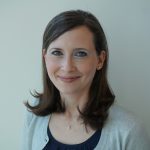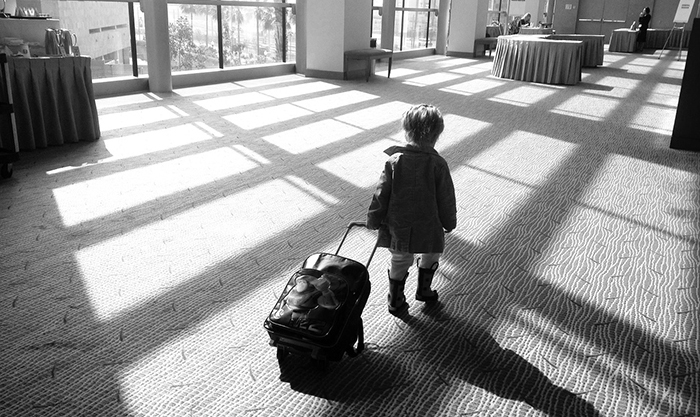Increasing support for parents in science means making conferences more child-friendly.
Guest post by Elisabeth Marnik and Julie Claycomb, members of the GSA Conference Childcare Committee.
The scientific community works on the cutting edge. We implement new techniques and methods as soon as we can with the understanding that—though there may be challenges along the way—the end result is worth it. We hope that this mindset will also hold true with regard to scientists implementing important changes in relation to parenthood and attendance at scientific meetings. In a 2018 PNAS article, Rebecca Calisi and a Working Group of Mothers in Science outlined the “childcare–conference conundrum”:
“Primary caretakers of dependent children face inequitable hurdles to fully attending and participating in conference activities because of responsibilities related to pregnancy, breastfeeding, and caretaking. It’s a serious problem because it creates a culture of inequity for parents, with mothers generally experiencing greater disadvantages than fathers because of biological, prejudicial, and often socially driven childcare demands.”
The article suggests changes that need to happen within the scientific community to help alleviate this unfair “baby penalty.” Based on the recommendations from Calisi et al. and the results of our survey earlier this year, the GSA Conference Childcare Committee is working to implement new policies and offer new resources for TAGC 2020. As is true of any new change, there will likely be some bumps in the road, but expanding our support for parents in science is an important step on the path to making things more equal. Ultimately, lowering barriers to participation will contribute to a more diverse community and benefit scientific progress overall as smart minds—belonging to those who happen to be parents—are encouraged to fully engage and remain in their field.
The following resources will be available at TAGC 2020:
- On-site childcare (at a cost)
- Nursing/pumping rooms
- Grants to help offset the costs of childcare associated with attending the meeting (applications due December 5!)
- Reserved seating at the back of large meeting rooms to allow parents easy access in and out of sessions
- Badges to allow additional caregivers access to meeting spaces for drop-off/pick-up
These are important steps in making conference attendance more inclusive, but a big part of the equation is a needed shift in conference culture that tells parents, “You’re wanted and welcome here!” That’s why we’re saying, loud and clear, that infants and children are welcome at TAGC 2020 and allowed in plenary and poster sessions. To make this work, we need parents and non–parents to come together and adapt. The shift might not be easy at first, but as highlighted in Calisi et al.: “Minor interruptions are a small price to pay for this step toward inclusion, which benefits mothers [parents] in science and, by extension, the academic enterprise.” In hopes of making this a better experience for all involved, we offer the following suggestions and tips to attendees bringing children and those who aren’t:
For those bringing children:
- Bring along another caregiver to help or utilize on-site childcare options when possible.
- Take advantage of childcare grants to help provide for childcare at home or at the meeting.
- Network with other parent scientists through the Parents in Science Slack and the Parents in Science Meetup at TAGC 2020.
- Coordinate with other parents to arrange playdates and meetups during the conference. Look for others that would be willing to work together on childcare arrangements.
- Ask a colleague for their session notes if you miss part of a session due to your child’s needs.
- Bring snacks, coloring books, puzzles, and other quiet activities to help entertain children during sessions.
- Remove disruptive or fussy children from session rooms until they are settled down. Many session rooms will have a remote viewing option so that you don’t have to miss the science if you need to exit with a fussy child.
- Keep an eye on safety. Children 12 and under must be accompanied at all times in conference spaces, and running, performing gymnastics, and other physical exertions are not permitted in any conference areas. Note that children are not allowed in the exhibit/poster hall during set-up or break-down times.
- Be patient with yourself and your child. There may be some challenges to navigating TAGC 2020 with your child, but you are taking an important step in doing so!
For those attending without children:
- Leave the reserved rows at the back of plenary sessions free for those with children so they can easily exit the room when needed.
- Avoid stirring up a child who may be misbehaving.
- Be respectful of nursing mothers/infants.
- Do not harass a parent about their child’s presence or behavior in a session.
- Practice empathy. No parent wants to disrupt a session with an unruly child, and every parent is acutely aware of their child’s behavior in situations like this.
- Be an ally. Recognize that parents bringing children to the conference may be outside of their comfort zone, too, but that to change our culture, we all need to work together.
We recognize that change like this might feel uncomfortable to some; however, we’re committed to doing what we can to address this particular contribution to the “leaky pipeline” of women in science. This isn’t a challenge that is unique to women; parents and caregivers of all genders can face hardships balancing a career in the sciences and parenthood. But it’s true that much of the career penalty that can come from having children is borne by mothers. There is a long-standing perception that science and motherhood are not compatible; it’s up to us to change that perception by providing better support for all parents in science.
It is our job as a community to ensure that talented scientists can succeed in their careers regardless of their decision to be parents. We hope you’ll join us in working to make TAGC 2020 inclusive to all attendees.
FURTHER READING
Problems in the Pipeline: Gender, Marriage, and Fertility in the Ivory Tower
Nicholas H. Wolfinger, Mary Ann Mason, and Marc Goulden
The Journal of Higher Education. 2008. 79(4): 388-405. doi: 10.1080/00221546.2008.11772108
Keeping Women in the Science Pipeline
Marc Goulden, Mary Ann Mason, and Karie Frasch
The Annals of the American Academy of Political and Social Science. 2011. 638(1): 141-162. doi: 10.1177/0002716211416925
Do Babies Matter?: Gender and Family in the Ivory Tower
Mary Ann Mason, Nicholas H. Wolfinger, and Marc Goulden
About the authors:

Elisabeth Marnik
Elisabeth Marnik is a Postdoctoral Research Associate in the Updike Lab at The MDI Biological Laboratory in Bar Harbor, ME, mom to a 7-month-old boy, and a member of the GSA Conference Childcare Committee.

Julie Claycomb
Julie Claycomb is an Associate Professor and the Graduate Coordinator in the Department of Molecular Genetics at the University of Toronto, mom of a 2 and a half-year-old boy, and a member of the GSA’s Conference Childcare Committee.













